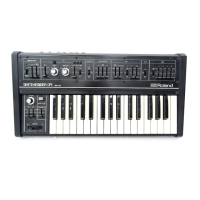Keyboard
Gate
Each key
on
the
SH-09 keyboard can produce an
on/off signal called a
Keyboard
Gate. The
Keyboard
Gate
(KG) is
a
voltage that
remains at
zero
until any key is pressed, jumping
instantly
to a
steady
voltage
zero
again.
Legato playing will result
in one long
gate
beginning
with the first note
play-
ed
and
ending
the
first moment
that no keys are
depressed.
14
Switch
the VCA from
Hold
to the Gate
position
anc
familiarize
yourself with
the
low
note priority
logic
for
the
KCV
and with the
Keyboard
Gate Pay
par-
ticular
attention
to detached
and legato
playing,
these will
have
a
significant
influence
on your
sound.
Keyboard
Trigger
Each time
a key is depressed on the SH-09,
an
impulse
signal is produced called a Keyboard Trig-
ger.
The Trigger
is
actually
a
voltage
spike that
ends
virtually the instant it is begun, no matter
how
long
you hold
a
key.
The
Keyboard Triggers follow
low note priority
logic the same
way
the
KCV
does
—
in
legato playing, new keys depressed
to the
left
will
introduce
a
new trigger
while
new keys
at the
right
will not trigger until any keys
to
its left are
released.
The Keyboard Trigger is
used
only in
conjunction
with
the
Keyboard Gate
to
activate
the
SH-09
Envelope.
To use the Gate and
Trigger
combina-
tion,
switch the
VCA
to
Envelope control.
Notes
now
played
will
have
a
distinctly different
shape
than the
simple on/off of
the
Gate
position,
and
legato
playing
will
yield
a
renewed"
attack
for
each
note
within
the
logic
described above. This techni-
que
will
be described
in
more detail in the follow-
ing Envelope section and in
the Application section
later in this manual.
Envelope
Generator
An
Envelope
is a
control
that produces a shaped
voltage once each time it is activated,
a
voltage
that is normally
used
to produce
a
change in
volume, tone, and/or
pitch once each time a key is
struck. The SH-09
uses a
complete four section
ADSR Envelope
that may be activated three
different ways, important features that help make
the SH-09
the
flexible, sensitive
synthesizer that it
is.
The
Envelope is often referred
to as
an ADSR,
a
term made from
the
initial
letters of the words
Attack,
Decay, Sustain and Release
—
the four
slider
functions within the Envelope. Leave the VCA
in the Envelope position, lower
the
ADSR
sliders to
'0',
and experiment
with pressing a single key for
short and long notes
as you proceed
through the
Envelope section. (In
this application
the ADSR is
responsible for
the shape of
the volume of
the note
only,
and all descriptions
will fit this frame
of
reference.)
With
all four Envelope
sliders
at
'0',
you
will
hear a
'click'
as you press a key
—
the sound of
the
Envelope acting
too quickly for
a
note
to
be
heard.
This click
is also heard lat
the beginning
of any
notes
with
an Attack of
'0',
and is
essential
to
sound
such as Vibes or Guitar
where
the impact of
the mallet or the plucking
of the string
is actually
a
part
of the sound.
Examples of this
may
be found
in
the Application and
Patch
sections of this
manual.
ATTACK
The
Attach slider
controls the time needed for the
beginning
of a note
to
grow from
silence to
full
volume. The
Attack functions
from the instant
a
key
is depressed until
the note reaches full volume or
the
key is released. Move
the
Attack slider
to
'10'
and
hold any key down
—
the sound will build gra-
dually from silence
to
full
volume, cutting instantly
back
to
silence
the moment that full volume
is
reached.
If
you pick
up the key before the Attack
has reached full volume,
it will end
at that point
This allows
you to control volume,
phrasing, bow-
ing,
etc. from the keyboard
for any
notes with
a
gradual attack
such
as
strings or
brass. Experiment
with this
principle and
check the
Application
sec-
tion
for more
specifics.
Lower
the Attack slider
to
'5'
and
notice that the
note reaches full
volume much
faster. Experiment
with various
Attack
speeds and note
lengths, notic-
ing
that the Attack
setting
does not directly alter
the volume of
any note
—
just the amount
of time
needed
to reach
the maximum.
Decay
The
Decay slider
controls the time
needed for
a
note
to
diminish
from full
volume
at the end
of
the
Attack to silence or
the level
set by the Sustain
function. Move
the Attack
slider to
'0',
raise the
Decay slider
to
'10',
and play
a long note. The note
will begin
at full volume
instantly
as
dictated
by
the
Attack slider, then
fade smoothly,
gradually to
silence
as long
as
your finger
is held
on the key.
The
Decay
is once again
only responsible for
the
note until
the key is released,
and raising
all keys
before the Decay
is complete will
again
end
in
abrupt
silence with our
settings. Experiment
with
various combinations
of Attack
and
Decay lengths,
ending with
settings of
'3'
for
each.

